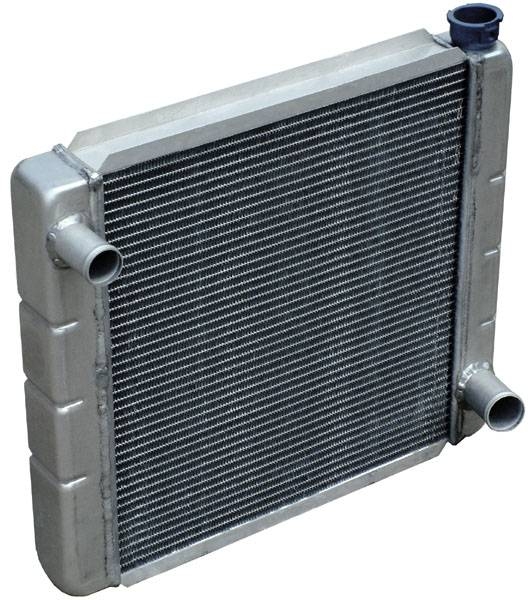
A car's radiator is used to help keep the engine cool. During operation, an engine's moving parts create friction, which produces heat. Even with the use of engine oil for lubricant, the heat from an engine's natural friction can be enough to damage the engine if it is not kept cool by the radiator. Once the engine reaches a certain temperature, the radiator is engaged to keep the engine from overheating, which, if it does, can cause catastrophic damage.
The radiator, which usually sits near the front of the engine bay in a front engine car, is constructed of thin, hollow passageways that run between two header tanks. Liquid coolant is pumped through a series of channels that take it through the engine block, where it is warmed by the engine's friction. The warmed liquid is then pumped to the radiator, where it makes its way through the narrow passageways. The radiator is constructed to have passageways with a high surface area, so that as the liquid passes through, it is cooled by air rushing over the radiator (usually this air is allowed in through the car's front grille). The coolant loses its heat to the atmosphere and is then pumped back into the engine where it absorbs and removes more of the engine's heat. This continuous cycle is controlled by a thermostat that keeps the engine operating at an optimal temperature near 200-degrees Fahrenheit.
The most important feature of a radiator is the construction of the core of passageways that run between the header tanks. This core comprises a circuit the warm engine coolant will pass through as it is cooled. Traditionally, brass and copper were used for building radiator cores, due to their thermodynamic qualities. Today, aluminum is used, largely due to its low cost and light weight. Plastic header tanks are common for the same reasons.
Radiators use different patterns for the channels that comprise the core, but, in all cases, a high ratio or surface area to volume is important. This allows the engine coolant to lose its heat more quickly so that it will be cooler when it returns to the engine and thus able to absorb more of the engine's heat. Air flow over the radiator is controlled by the speed of the vehicle and may be supplemented with an electric fan that can make the radiator more effective at low speeds or while the vehicle is idling.
The effectiveness of a cooling system is also affected by the nature of the coolant itself. In early automobiles, the coolant was usually water. If a vehicle was to be driven in cold weather, antifreeze was added to prevent the coolant from freezing in the header tanks. Eventually, different chemical solutions were experimented with to provide more effective cooling.
Modern coolant is usually comprised of propylene glycol or ethylene glycol. In most cases, a chemical is added to prevent corrosion. This has been standard practice since the introduction of aluminum in the construction of radiators.
Water is still an effective coolant, but will quickly boil off once the engine is run at a regular temperature. However, in emergency situations water can be used to keep a car's engine cool enough to operate and avoid damage.
The typical automobile radiator is rather simple in design and construction. As such, mechanical breakdown is usually repairable and results from the degradation of materials. Leaks in the header tanks, radiator core or in the rubber hoses that channel coolant between the radiator and engine can result in a slow loss of coolant that, over time, may prevent the engine from being cooled down to a safe operating temperature. Leakage in the engine itself can cause a more rapid problem, as the engine's high temperature will burn the coolant, producing white smoke and quickly depleting the coolant level, thus preventing the engine from being cooled. In cases such as these, water can be added or the engine can be stopped and allowed to cool naturally before being moved or repaired.
In addition to cooling the engine itself, some radiators contain a separate core for cooling engine oil. This is essentially a small radiator located near or attached to the main radiator, but functions in much the same way. In addition to cooling engine oil, some radiators are designed to cool transmission fluid as well. Collectively, radiators that cool more than just the engine are known as "supplemental radiators."
Another kind of supplemental radiator is sometimes used on cars that feature an intercooler as part of a turbocharger or supercharger system. The intercooler is used to cool the air that will be compressed by the turbo- or supercharger before it is forced into the engine for combustion.